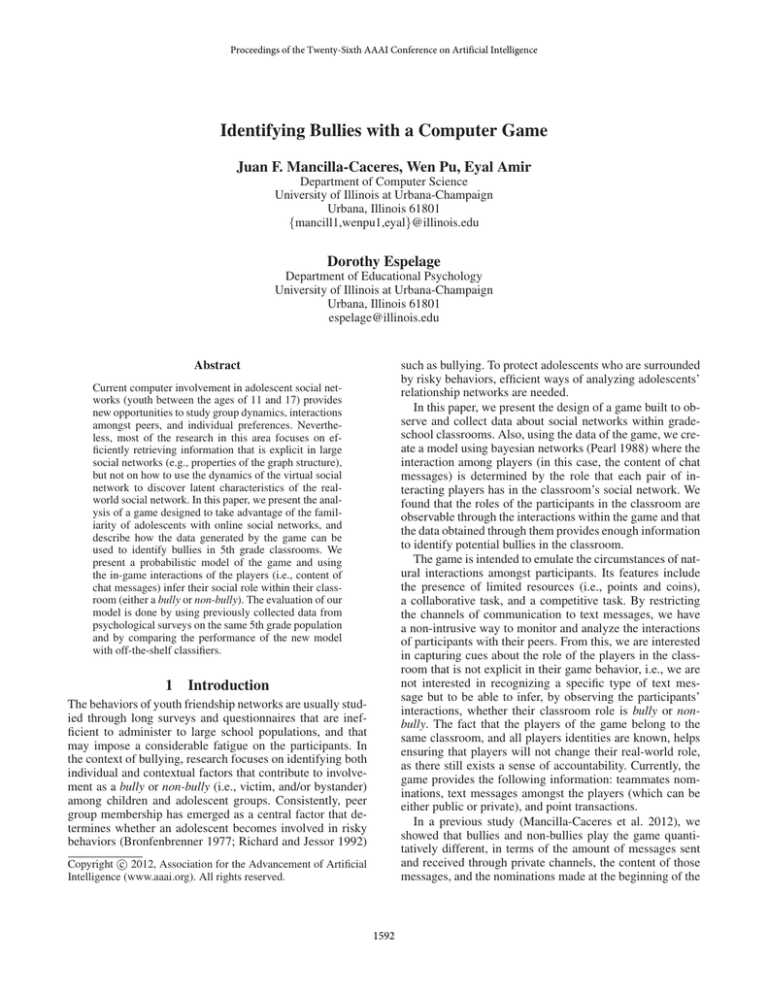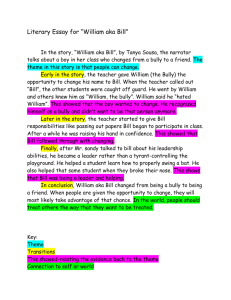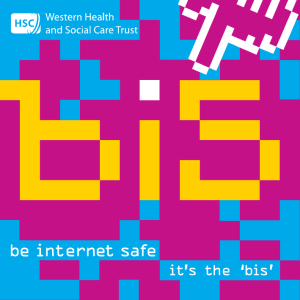
Proceedings of the Twenty-Sixth AAAI Conference on Artificial Intelligence
Identifying Bullies with a Computer Game
Juan F. Mancilla-Caceres, Wen Pu, Eyal Amir
Department of Computer Science
University of Illinois at Urbana-Champaign
Urbana, Illinois 61801
{mancill1,wenpu1,eyal}@illinois.edu
Dorothy Espelage
Department of Educational Psychology
University of Illinois at Urbana-Champaign
Urbana, Illinois 61801
espelage@illinois.edu
Abstract
such as bullying. To protect adolescents who are surrounded
by risky behaviors, efficient ways of analyzing adolescents’
relationship networks are needed.
In this paper, we present the design of a game built to observe and collect data about social networks within gradeschool classrooms. Also, using the data of the game, we create a model using bayesian networks (Pearl 1988) where the
interaction among players (in this case, the content of chat
messages) is determined by the role that each pair of interacting players has in the classroom’s social network. We
found that the roles of the participants in the classroom are
observable through the interactions within the game and that
the data obtained through them provides enough information
to identify potential bullies in the classroom.
The game is intended to emulate the circumstances of natural interactions amongst participants. Its features include
the presence of limited resources (i.e., points and coins),
a collaborative task, and a competitive task. By restricting
the channels of communication to text messages, we have
a non-intrusive way to monitor and analyze the interactions
of participants with their peers. From this, we are interested
in capturing cues about the role of the players in the classroom that is not explicit in their game behavior, i.e., we are
not interested in recognizing a specific type of text message but to be able to infer, by observing the participants’
interactions, whether their classroom role is bully or nonbully. The fact that the players of the game belong to the
same classroom, and all players identities are known, helps
ensuring that players will not change their real-world role,
as there still exists a sense of accountability. Currently, the
game provides the following information: teammates nominations, text messages amongst the players (which can be
either public or private), and point transactions.
In a previous study (Mancilla-Caceres et al. 2012), we
showed that bullies and non-bullies play the game quantitatively different, in terms of the amount of messages sent
and received through private channels, the content of those
messages, and the nominations made at the beginning of the
Current computer involvement in adolescent social networks (youth between the ages of 11 and 17) provides
new opportunities to study group dynamics, interactions
amongst peers, and individual preferences. Nevertheless, most of the research in this area focuses on efficiently retrieving information that is explicit in large
social networks (e.g., properties of the graph structure),
but not on how to use the dynamics of the virtual social
network to discover latent characteristics of the realworld social network. In this paper, we present the analysis of a game designed to take advantage of the familiarity of adolescents with online social networks, and
describe how the data generated by the game can be
used to identify bullies in 5th grade classrooms. We
present a probabilistic model of the game and using
the in-game interactions of the players (i.e., content of
chat messages) infer their social role within their classroom (either a bully or non-bully). The evaluation of our
model is done by using previously collected data from
psychological surveys on the same 5th grade population
and by comparing the performance of the new model
with off-the-shelf classifiers.
1
Introduction
The behaviors of youth friendship networks are usually studied through long surveys and questionnaires that are inefficient to administer to large school populations, and that
may impose a considerable fatigue on the participants. In
the context of bullying, research focuses on identifying both
individual and contextual factors that contribute to involvement as a bully or non-bully (i.e., victim, and/or bystander)
among children and adolescent groups. Consistently, peer
group membership has emerged as a central factor that determines whether an adolescent becomes involved in risky
behaviors (Bronfenbrenner 1977; Richard and Jessor 1992)
c 2012, Association for the Advancement of Artificial
Copyright Intelligence (www.aaai.org). All rights reserved.
1592
the wrong answer, but also to ensure that someone else in
their team picks it. Given the restricted channel of communication, this can only be achieved by negotiating (either aggressively or not) through the chat channel. These coercive
strategies may also be used to obtain coins from other players.
As previously mentioned, the winner of the game is the
player with the largest amount of coins. The team with the
largest cumulative score (i.e., the sum of all the individual
rewards) also gets awarded a team prize.
Every time the game is played, the following information
is obtained:
game. In total, ninety seven 5th graders from six different
classrooms and two different Midwestern middle-schools
were surveyed using state-of-the-art psychological questionnaires and were labeled as either bullies or non-bullies by a
field expert.
2
Game Design
Traditionally, surveys are used to collect information about
peer relations in classrooms. The administration of these surveys is usually costly and burdensome. Instead, we designed
an online multiplayer trivia game (played by 5th graders belonging to the same classroom) used to obtain meaningful
observations about peer relations. The game is played as follows:
1. Nominations: Users’ team preferences (friends/rivals
nominations and the order in which they are selected).
• Stage 1. At the beginning of the game, each player nominates other players whom they would (or would not) like
to have as members of their team. This information is interpreted as a sign of possible friendship but it is not used
to create the teams, which are previously created using the
data from the survey (ensuring that in every team there is
at least one player classified as a bully).
2. Interactions: Raw messages from users (all chat messages
both in public and private channels along with the time
at which the message was sent), and Points transactions,
e.g., transfer and forfeiture of points (in exchange for information). The content of each message was analyzed
by 20 independent raters (each message evaluated by two
raters) and classified into 2 categories: Prosocial/Coercive
(whether the purpose of the message is to coerce the recipient into doing something not optimal for themselves),
and Positive/Negative Affect (whether the sentiment expressed by the sender is either positive or negative).
• Stage 2. After the nomination stage, players on the same
team collaborate to answer a set of 5 trivia questions about
general knowledge by choosing one of four possible answers. The team must ensure that all its members submit
the same (correct) answer or no player receives their reward (in the form of coins).
• Stage 3. After the collaborative stage, the game turns adversarial. The team must now answer another set of 5
trivia questions, but in this case all members must select a
different answer with the caveat that one of the answers is
marked as wrong. Unless every member submits a different answer, and one member selects the wrong one, nobody gets the reward (the player who selects the wrong
answer gets nothing).
Survey
We also collected information with a survey to measure
aggression and delinquency (Espelage and Holt 2001; Espelage, Mebane, and Adams 2004), which includes different
scales to assess various types of bullying behavior (e.g., teasing other students), fighting behavior (e.g., being in a physical fight), participants’ attitudes and perceived attitudes
among friends towards bullying and the extent to which they
would assist a victim, and the extent to which students agree
that they are leaders among their peers, make decisions for
friends, and force others to do what they ask. Past research
demonstrated that the scales converges with peer and selfnomination reports of bullying (Espelage and Holt 2001).
All participants were surveyed with the previously described questionnaires, and an expert psychologist analyzed
the surveys and generated labels for each participant as either bully, or non-bully. The survey data was used to generate the labels that will later be used to train the model and to
evaluate the results yielded by the computer game. The ultimate goal is to develop appropriate psychometric measures
solely through the data provided by the computer game (i.e.,
chat messages, in-game transactions, etc.).
Our main hypotheses are that those students who are labeled as bullies, will have a need for control and dominance,
will engage in coercive tactics directed toward non-friends,
and will solicit support for these tactics from friends within
and outside their team. These will be tested by observing
the emotional tone (or content) of the messages sent in all
pairwise interactions of players in the game.
At the end of the game, the player with the highest score
receives a prize (in form of a gift card), encouraging players to oppose their fellow teammates by coercing them to
pick the wrong answer (unlike in the collaborative stage, in
which the team is encouraged to work together to maximize
their individual reward). Also, during all stages of the game,
players are allowed to make coin transactions and to peek at
the answer at the cost of some of their coins. Figure 1 shows
a screenshot of the game interface for the nomination stage,
and one of the trivia stages.
These rules ensure that the players in the team communicate through the chat interface, and either collaborate or
compete (depending on the stage) in order to guarantee
the best possible individual output. During the collaborative
stage, it is in the best interest of each player to share their
knowledge about the question and not to let other players
answer incorrectly or peek at the answer (in order to retain
points).
During the adversarial stage, the wrong answer is marked
explicitly (written in bold letters) in order to make it obvious and to encourage players to discuss who will pick such
answer. It is in the best interest of each player not to pick
1593
Figure 1: Screenshot of the game. Left image shows the interface to nominate desired teammates. Right image shows a sample
question and interface to select an answer.
3
Modeling the Game
Some assumptions are necessary in order to properly model
the game. First, the chat messages in the game are unrestricted and written in natural language, which means that
the messages must be classified into a small set in order to
be able to create appropriate probability distributions. Currently, we are avoiding the need for advanced NLP techniques by having the messages classified by a team of 20
raters (each message was classified by at least two raters)
into 2 binary categories: Prosocial/Coercive messages, and
Positive/Negative messages.
We considered all pairwise interactions among players independently, i.e., for each pair of players that interacted during gameplay we gathered: the amount of messages sent by
one of the players in the pair (the sender) to the other (the
recipient), the nomination given by the sender to the recipient (as either positive, negative, or don’t care), and whether
or not they belonged to the same team.
Figure 2 shows a fragment of the proposed bayesian network for one of the classrooms. Notice that each player may
interact through a private channel with any of the students of
his/her class. The messages sent through this channel may
either constitute a prosocial message (e.g., helpful, agreeable, polite, etc.) or coercive (e.g., rude, aggressive, etc.),
and may express positive affect (e.g., happy, humorous, etc.)
or negative affect (e.g., bored, sad, etc.). Our model assumes that the roles of the sender and the recipient determine whether the message is either prosocial or coercive,
and expresses positive or negative affect.
The roles of the players also determine whether one nominated the other to be on his team (presumably, a victim
would not nominate his bully to be in his team, and bullies might nominate each other). The fact that two players are on the same team may also help in understanding
the observed interactions. For example, a bully and a nonbully on the same team may cooperate more (have more
prosocial messages than coercive) in order to win the game,
whereas a bully and a victim on different teams may show
a less friendly interaction. In summary, our model considers
four observable features for each pair of interacting players:
prosocial/coercive messages, positive/negative messages,
Figure 2: Example of the bayesian network used to model
the game’s interactions. For each player S, we will consider
all the pairwise interactions with the rest of the classroom.
For every pair of players, the sender S and the recipient R,
we observe whether the interaction was Prosocial or Coercive (C), Positive or Negative (N ), whether S nominated R
(O) and whether they belong to the same team (T ).
nominations, and team membership. In this model, we do
not consider points transactions between players.
This model implies that, to obtain the probability of a
player being a bully, we need to observe the interactions of
the specific participant with all other participants. We build
the training set as follows:
1. For each pair of participants, we identify one as the sender
of messages, and the other as the recipient (this implies
that the training set also contains a pair where the former
recipient is now the sender, and viceversa).
2. We compare the number of prosocial and coercive messages sent by the sender and create a binary variable C
which takes the value of 1 if the number of coercive messages is greater of equal to the number of prosocial messages sent, and the value of 0 if otherwise.
3. In a similar way, we create a binary variable N that takes
the value of 1 whenever the number of negative messages
sent is greater or equal to the number of positive messages.
1594
S
non-bully
non-bully
bully
bully
R
bully
non-bully
non-bully
bully
C
1
0
0
0
N
1
1
1
0
O
1
1
-1
0
T
0
0
0
1
balance (Elkan and Noto 2008). In this work, we opted for
changing the decision threshold due to the intuition that, in
our case, it is appropriate to identify as bully those participants who have the highest probability of being a bully, regardless of the actual absolute value of the probability.
Table 1: Examples of training data. Each row represents a
training point defined by the interaction of a sender (S) and
a recipient (R) that was either prosocial or coercive (C), positive or negative (N), with a specific nomination (O), and
either belonging to the same or to a different team (T).
4
Experiments and Evaluation
Even if a particular player was labeled as a bully using the
survey, it does not imply that he will bully all the classmates with whom he/she interacts. For example, the fact that
a bully may be coercive towards his victim, does not rule out
the possibility of himself behaving nice and cooperative with
the rest of people he interacts with. Therefore, we are interested in calculating, for each training point (i.e., each pair of
sender-recipient variables) the probability PiS of the sender
S being a bully given his interaction with recipient i and the
observed values of the rest of the variables.
4. The other two variables are O, if the sender nominated
positively, negatively, or did not care about having the recipient on the same team. And T if the sender and the
recipient belong to the same team or not.
There are five binary variables: sender which can be either
bully or non-bully, recipient which can also be either bully
or non-bully, C, N , and T ; and a variable with three possible
values O for a total of 96 possible values. Given the size of
the complete social network, determined by the number of
pairwise interactions (a total of 597) and the possible values
of the variables, it is possible to find the exact probability of
any given sender to be a bully given the observation of the
four features (and marginalizing over the recipient whose
value is unknown). Table 1 shows some examples of how a
training point looks.
P
PiS
P (S, Ri = r, C, N, O.T )
= P (S|C, N, O, T ) = PP
P (S, R, C, N, O, T )
r
s r
(1)
This training procedure will generate n different probabilities for one specific sender, where n is the number of
pairwise interactions of the sender. Because our survey data
does not include information about pairwise interactions, we
need to consolidate the n probabilities and obtain only one
per player. It is our intuition that non-bullies will have a low
probability of being a bully across all the interactions they
have, whereas a bully will have at least one interaction with
high probability. Therefore, the probability of a sender S
being a bully (P̄ S ) is the average over all the probabilities
across all the sender’s interactions (See equation 2). It is expected that non-bullies will have a lower P̄ S than bullies.
Handling Imbalance in the Data
One of the challenges to address is the intrinsic imbalance
in the data; there tends to be a larger number of non-bullies
than bullies in every classroom. In our dataset, the average
number of bullies per class is 2, whereas the average size of a
classroom is 15 students. That gives us a prior probability of
0.12 of being a bully and, across all classrooms, the entropy
of the dataset is 2.474. This is a challenge because most offthe-shelf classifiers have an implicit decision threshold that
assumes that both positive and negative classes are balanced,
i.e., there is a 0.5 probability of a random example being a
member of the positive class (in our case, of being a bully).
This implies in our dataset that any observed interaction has
a greater probability of coming from the interaction of two
non-bullies (the majority class) than from any other possible
combination (bully- non-bully, or bully-bully). This is exacerbated by the fact that interactions between bullies and nonbullies are not explicit, i.e., the way bullies interact with nonbullies is not necessarily salient. For example, finding a bully
is not as easy as finding the kid who says (or writes) more
swear words, or who explicitly asks for money from another
student. Therefore, interactions between the two most common roles (non-bullies) are more likely to be observed.
The data mining literature provides several ways to deal
with this phenomenon (sometimes referred to as novelty detection). Among those suggestions are oversampling the minority class (Noto, Saier, and Elkan 2008), changing the
decision threshold whenever possible (Maloof 2003) or redefining the negative and positive class to overcome the im-
P̄ S =
1X S
P
n i i
(2)
If we imagine the real-world scenario of using our game
as a tool to identify bullies in a previously unseen classroom,
we can see that the best method for evaluation is leave-oneclassroom-out, i.e., train on five of the available classrooms
and evaluate on the sixth one. This is done using as test one
classroom at a time, in a cross-fold validation fashion.
After training the bayesian network and averaging all the
probabilities for each sender, we look for the optimal decision threshold thr to label a particular player as a bully. This
was done by looking for the threshold that, on the training
set, gave the best possible combination of accuracy (acc),
recall (rec), and precision (pre).
thr = argmax (acc (thr) × rec (thr) × pre (thr)) (3)
thr∈(0,1)
where the measures of performance are defined as follows:
1595
acc(thr)
=
rec(thr)
=
pre(thr)
=
tpthr + tnthr
tpthr + f nthr + tnthr + f pthr
tpthr
tpthr + f nthr
tpthr
tpthr + f pthr
(4)
(5)
(6)
where tpthr , f nthr , tnthr , and f pthr stand for true positive, false negatives, true negatives, and false positives
(while using thr as threshold), respectively. To obtain these
values we need to count how many senders have a probability P̄ S higher (or lower) than thr and were labeled using the
surveys as either bullies or non-bullies.
That is, accuracy is the number of correct label assignments for both the positive and the negative class (bully,
non-bully, respectively). Recall is the number of correctly
identified bullies, from all the available bullies. And, precision is the the number of correct label assignments from all
the assignments done. All three measures of performance
were used to keep in mind all possible scenarios in which
our method might be used, and to overcome the shortcomings of each of these measures.
Accuracy, although probably the most common measure
of performance, might be unreliable in cases where the data
is imbalanced (as is ours) because a classifier might optimize
this value by simply choosing to label all instances with the
label of the majority, in our case, this would automatically
obtain an accuracy of 0.88 which is the ratio of non-bullies
in the dataset. Recall is also a very common measurement
of performance, the problem in our case is that, because we
are choosing the decision threshold during training, the optimization could always select the lowest possible threshold
and label all players as bullies, which would ensure that all
available bullies are correctly labeled, even though it is generating the maximum number of false positives. On the other
hand, optimizing precision may lead to the problem of minimizing the number of participants labeled as bullies, in order to minimize the chance of having false positives (i.e., we
could potentially have an unlimited number of false negatives). Because it is desirable that our system is capable of
identifying all possible bullies in a classroom, and not only
the ones who are clearly bullies, the best decision threshold
thr, is the one who maximizes all of the three performance
measures.
Figure 3: Comparison between off-the-shelf classifiers and
our bayesian network, which accomplishes a good trade-off
between accuracy and recall, and having significantly higher
accuracy than all other methods (except Naive Bayes).
by LIBSVM (Chang and Lin 2011) using a radial kernel),
One-Class SVM (Schlkopf et al. 2001) (also, as implemented by LIBSVM), Logistic Regression, Random Trees
and Naive Bayes Classifier (the last three as implemented
on the WEKA Data Mining platform (Hall et al. 2009) with
standard parameters). The results of these experiments are
shown in Figure 3. It shows the average performance of each
of the methods, and the standard error as error bars.
In order to compare the performance of each of the different classifiers (on the three performance measures), a series
of t-tests were performed to look for significant differences.
The first thing to notice is that all methods perform similarly
with respect to precision (i.e., there was no statistically significant difference when comparing the precision between
any two methods), and this value is low. This means that all
methods produce a relatively large number of false positives
in comparison to the number of true positives found. Improving on this value will be the focus of future work (i.e.,
finding a model or classifier which is able to better distinguish amongst non-bullies and bullies given the data from
the game). Therefore, we need to rely only on accuracy and
recall to decide which classifier performs best. The method
with the highest recall is SVM (significantly better recall
than Random Trees), and, as suspected, the cost of having
an almost perfect recall is that of having a very low accuracy (it is actually the classifier with the smallest accuracy
across all methods, i.e., SVM caused the threshold to be very
low and therefore erroneously claiming that most, if not all,
of the participants are bullies). In general, as methods improve on accuracy, the recall drops, except when using the
bayesian network described in this paper.
Statistically speaking, the bayesian network has the highest accuracy, which is significantly larger than the accuracy
of all other methods, except that of Naive Bayes. In the case
of recall, none of the methods (not even SVM) generates a
statistically significantly larger recall than the bayesian net-
Comparison with Other Classifiers
Once a threshold is found during training, the test consists on
obtaining the probability of a specific sender being a bully
for each interacting pair in the test set, averaging the probabilities for each participant to obtain P̄ S , and comparing
this probability with the threshold. This allows us to obtain,
for the current classroom, the values of accuracy, recall, and
precision.
This training and testing procedure was performed using the model defined by the bayesian network described
above and five other off-the-shelf classifiers. These classifiers were ν-SVM (Schölkopf et al. 2000) (as implemented
1596
network and not explicit in the network) using the content
of the interactions of the users in the social network. In our
case, the online social network reflects the real world social
structure because all the players belong to the same classroom, which allows us to infer real world behaviors. On the
other hand, this might not be possible to do in current publicly available online social networks, because there is no
evidence that classroom roles are reflected in such networks.
Regarding the use of automatic methods to detect dangerous behavior in online communities, previous research has
focused on cyber-bullying and not on physical bullying as
we do. For example, (Lieberman, Dinakar, and Jones 2011)
focuses exclusively on observable behavior (e.g., finding insulting or racist messages on status updates to online social networks), whereas our approach is aimed at finding the
latent behavior associated with children’s roles within the
classroom, which may or may not be explicit in the game.
Game-based methods for data collection have been successfully used in the past to generate and collect data from
social networks. Some examples are Collabio (Bernstein et
al. 2009), designed to generate social tags amongst friends
in Facebook, and the Turing Game (Mancilla-Caceres and
Amir 2011), which encourages Facebook users to evaluate commonsense knowledge through a set of carefully designed rules and stages. Also, previous studies have shown
that it is possible to observe real world behavior (e.g., bystander effect) in virtual game environments (Kozlov and
Johansen 2010). The game described in this paper differs
from previous games in the sense that the desired outcome
of the game is not the specific actions the players take on
the game (i.e., the classification of the image or text by the
player) but the interactions amongst the players. This is a
novel approach to gather data because, although the design
of the game is important to encourage participation and engagement, the actual game task is not crucial. Also, most
of the other games for data collection can be played by a
single person, but our game requires teams that belong to
a pre-existing social network, which allows us to gather
information about the existing social group. This kind of
game is especially useful for data-collection in the social
sciences because the games provide a natural data-intensive,
non-intrusive interaction with participants. The game is applied here to learn about social communications, manipulation methods, and reactions to natural occurrences of friendliness or aggression.
work model. This is due to the large variance of the recall on
this method. (Actually, the only statistically significant difference in recall is given by SVM over Random Trees and
One-Class SVM over Random Trees).
Given these results, the only two methods that did not performed statistically worse than any other were the bayesian
network and the naive bayes approach. Interestingly, they
both seem to complement each other in the sense that naive
bayes emphasizes recall over accuracy, whereas the bayesian
network approach slightly emphasizes accuracy over recall,
neither of them being significantly different from the other.
Another thing to notice in this comparison is that, although
the average recall obtained with the bayesian network is
high, the variance is also large, which means that it may
be unreliable (i.e., for some classrooms, the recall might be
very bad), whereas the naive bayes tends to be more consistent across classrooms.
Also, in the real life scenario where the game can be used
by teachers to identify students with a high probability of
being bullies, recall might be more beneficial than accuracy
in the sense that it would not be too costly to pay special attention to some false positives (which might be easily identifiable by the teacher as non-bullies).
Another important issue to address during this evaluation
is the relatively low absolute values of both accuracy and recall, which in the case of our method (the bayesian network)
are only slightly larger than 0.5. The most likely explanation
for this is that either the model or the game is unable to effectively capture and identify the interaction patterns of all bullies in the game. Most likely, we are only capturing the patterns in the behavior of half the bullies. Although alarming
at first, we have come to realize that psychological research
(Seigne et al. 2007; Monks, Smith, and Swettenham 2005;
Naubuzoka 2009) on bullying has found that there are two
main types of bullies: those which have high executive functions (i.e., high capacity of negotiating such that they manage to get their way with both victims and teachers) and
those with low executive functions (i.e., those with low
capability of negotiating, get frustrated fast and disengage
from socially accepted interactions). It is clear that the game
would more easily detect those with high executive functions who manage to use the chat interface to manipulate
their way into winning the game, whereas those with low executive functions will simply disengage from the game and
stop contributing messages in the chat interface, making it
extremely difficult for our game and model to identify them.
5
6
Related Work
Conclusions and Future Work
The results of these experiments, although allowing for
some improvement, show great promise regarding the capability of the game of detecting a certain type of bully,
while causing less fatigue to the participants (5th graders
that played the game expressed a lot of enjoyment regarding
their playing experience). Our system is capable of reporting
to a teacher the identity of those children with high probability of being bullies, hopefully giving them the opportunity
for early detection and intervention.
In future work, it is very important to focus on improving the precision of our results. This can be done in several
With respect to methods of inference in social networks, in
(Groh and Hauffa 2011) the authors showed a method for using the content of messages such as the emotional intensity,
and other NLP-based sentiment classification methods to analyze email messages and to characterize social relations.
(Paradesi and Shih 2011) showed the possibility of using
data publicly available from different online social networks
to make inferences about health habits using keyword cooccurrences. These two examples of recent research show
the interest in the use of social networks to recognize important behavior in the real world (i.e., outside the social
1597
ways: The first option is to change the model such that it includes more information that is currently available from the
game (e.g., point transactions, conversations in the chat public channel, final score in the game, etc.). Second, it would
be appropriate to develop a better way to handle the imbalance in the data, for example, combining the power of maxmargin methods (such as SVM) with the simplicity of naive
bayes may prove useful as well as including background
knowledge to allow our system to identify not only bullies
with high executive functions but also those with low executive functions.
7
reality paradigm using video games. Cyberpsychology, behavior, and social networking. 13:711–714.
Lieberman, H.; Dinakar, K.; and Jones, B. 2011. Let’s gang
up on cyberbullying. IEEE Computer 93–96.
Maloof, M. A. 2003. Learning when data sets are imbalanced and when costs are unequal and unknown. In ICML
2003 Workshop on learning from imbalanced data sets II,
volume 21, 1263–1284.
Mancilla-Caceres, J. F., and Amir, E. 2011. Evaluating commonsense knowledge with a computer game. In Campos,
P. F.; Graham, T. C. N.; Jorge, J. A.; Nunes, N. J.; Palanque,
P. A.; and Winckler, M., eds., INTERACT (1), volume 6946
of Lecture Notes in Computer Science, 348–355. Springer.
Mancilla-Caceres, J. F.; Pu, W.; Amir, E.; and Espelage, D.
2012. A computer-in-the-loop approach for detecting bullies in the classroom. In Yang, S. J.; Greenberg, A. M.; and
Endsley, M. R., eds., SBP, volume 7227 of Lecture Notes in
Computer Science, 139–146. Springer.
Monks, C. P.; Smith, P. K.; and Swettenham, J. 2005. Psychological correlates of peer victimization in preschool: social cognitive skills, executive function and attachment profiles. Aggressive Behavior 31(6):571–588.
Naubuzoka, D. 2009. Teacher ratings and peer nominations
of bullying and other behaviour of children with and without
learning difficulties. Educational Psychology 23(3):307–
321.
Noto, K.; Saier, M.; and Elkan, C. 2008. Learning to find
relevant biological articles without negative training examples. In Ai 2008: Advances in Artificial Intelligence, volume
5360, 202–213.
Paradesi, S., and Shih, F. 2011. Globalidentifier: Unexpected personal social content with data on the web. International AAAI Conference on Weblogs and Social Media.
Pearl, J. 1988. Probabilistic reasoning in intelligent systems: networks of plausible inference. San Francisco, CA,
USA: Morgan Kaufmann Publishers Inc.
Richard, and Jessor. 1992. Risk behavior in adolescence: A
psychosocial framework for understanding and action. Developmental Review 12(4):374 – 390.
Schölkopf, B.; Smola, A. J.; Williamson, R. C.; and Bartlett,
P. L. 2000. New support vector algorithms. Neural Comput.
12:1207–1245.
Schlkopf, B.; Platt, J.; Shawe-Taylor, J.; Smola, A.; and
Williamson, R. 2001. Estimating the support of a highdimensional distribution. Neural Computation 13:1443–
1471.
Seigne, E.; Coyne, I.; Randall, P.; and Parker, J. 2007. Personality traits of bullies as a contributory factor in workplace
bullying: An exploratory study. International Journal of Organization Theory and Behavior 10(1):118–132.
Acknowledgments
This work was supported in part by NSF IIS grant 09-17123
titled Scaling Up Inference in Dynamic Systems with Logical
Structure, NSF IIS grant 09-68552 titled SoCS: Analyzing
Partially Observable Computer-Adolescent Networks, and
by a grant from the Defense Advanced Research Project
Agency (DARPA) as part of the Machine Reading Program
under Air Force Research Laboratory (AFRL) prime contract no. FA8750-09-C-0181. Any opinions, findings, and
conclusion or recommendations expressed in this material
are those of the author(s) and do not necessarily reflect the
view of the DARPA, AFRL, or the US government.
References
Bernstein, M.; Tan, D.; Smith, G.; Czerwinski, M.; and
Horvitz, E. 2009. Collabio: a game for annotating people
within social networks. In Proceedings of the 22nd annual
ACM symposium on User interface software and technology,
UIST ’09, 97–100. New York, NY, USA: ACM.
Bronfenbrenner, U. 1977. Toward and experimental ecology
of human development. American Psychologist 32(7):513–
531.
Chang, C.-C., and Lin, C.-J. 2011. LIBSVM: A library for
support vector machines. ACM Transactions on Intelligent
Systems and Technology 2:27:1–27:27.
Elkan, C., and Noto, K. 2008. Learning classifiers from
only positive and unlabeled data. In Proceedings of the
KDD’2008, 213–220.
Espelage, D., and Holt, M. 2001. Bullying and victimization
during early adolescence: Peer influences and psychosocial
correlates. Journal of Emotional Abuse 2:123–142.
Espelage, D.; Mebane, S.; and Adams, R. 2004. Empathy,
caring, and bullying: Toward an understanding of complex
associations. In Bullying in American Schools: A socialecological perspective on prevention and intervention, 37–
61. New Jersey, NJ, USA: Lawrence Erlbaum Associates.
Groh, G., and Hauffa, J. 2011. Characterizing social relations via nlp-based sentiment analysis. International AAAI
Conference on Weblogs and Social Media.
Hall, M.; Frank, E.; Holmes, G.; Pfahringer, B.; Reutemann,
P.; and Witten, I. H. 2009. The weka data mining software:
an update. SIGKDD Explor. Newsl. 11:10–18.
Kozlov, M., and Johansen, M. 2010. Real behavior in virtual
environments: psychology experiments in a simple virtual-
1598






